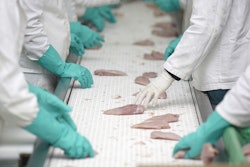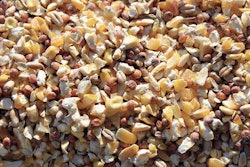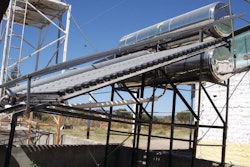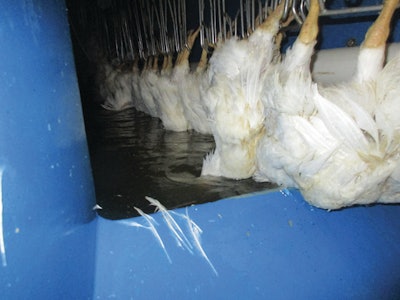
Poultry processing companies wanting to minimize waste and operating expenses, maximize output and lower costs, may want to consider how technological developments could be applied to their day to operations. Adopting new technologies can not only make operations more profitable but also improve the conditions of staff working in the plant.
There are various familiar and new technologies that could benefit operations, and a number of points along the line where, with creativity, they could be introduced.
Robots, either working solely or in conjunction with employees, could take on the most tiring tasks.
Take, for example, the hanging of carcasses on the drip line. This is a strenuous activity for workers who need to ensure that no shackles are left empty. Replacing workers with robots would not only free them from this tiring task but, given robots’ consistent performance, would ensure that there are no delays.
Another example is packing after the aerial drip line deposits birds into various bins depending on weight. Workers take these birds and bag and seal them before placing them onto a conveyor belt. If the carcasses are heavy, and the number to be bagged per minute high, workers will again quickly tire. Once again, robots could do this work, reducing the risk of bottlenecks.
Supplying carcasses to cut up cones
This is another tiring activity, depending on the weight of the birds being processes. Operators must take the carcasses out of their trays and lift them onto the cones ensuring that all cones are covered. Should workers be processing turkeys the effort needed to handle them is enormous. Additionally, those working at the cones are standing for most of the shift.
Cut op cones can be extremely tiring for plant personnel. Could this task be completed by robots?
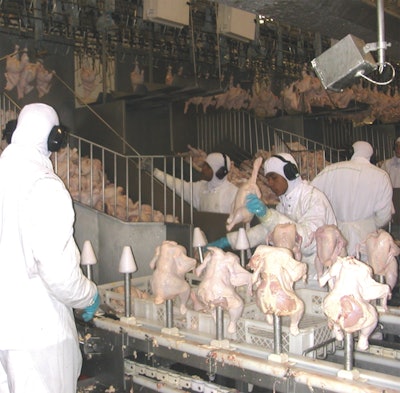
The question arises as to whether this task could be handed over to robots? | Eduardo Cervantes López
Smart electric stunning
Birds sent to slaughter tend to be of a uniform size, however, those that are below the lower limit are a daily challenge in terms of height adjustment at stunning.
The manufacturers of stunning equipment have achieved high levels of effectiveness, approximately 95%. However, in a plant that processes around 100,000 broilers per hour, 500 birds can still exit the stunner conscious. This is the equivalent of eight birds per hour.
In some countries, the animal health inspection service considers this number to be too high and may even suspend operations until the number is lowered.
While today’s stunning equipment may do a good job, could it be improved further still through the use of artificial intelligence?
If 50 bird were monitored prior to entering the stun cabinet and artificial intelligence were used to make the necessary calculations to adjust the height of the stun cabinet, the number of unstunned birds could be reduced. Additionally, intelligent systems could also adjust the voltage and amperage for reach batch of birds that enters the stun bath.
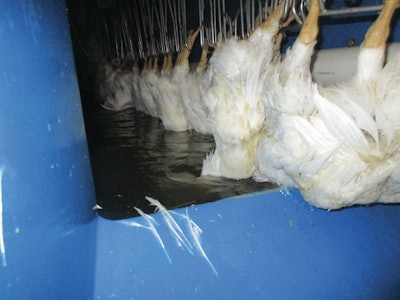
Applying artificial intelligence to stunning could ensure that fewer birds exit the stun bath conscious, beneficial for operational and welfare reasons. | Eduardo Cervantes López
Intelligent plucking
This is another operation with significant challenges, particularly removing feathers without causing damage to the carcass skin and not wearing out the rubber fingers, and plucking machine manufacturers have developed techniques that allow the plucker’s disk lines to be adjusted independently, achieving the most ergonomic contact possible.
Where there are two plucking machines in operation, it is recommended that machine one remove 70-80% of the feathers while machine two remove 20-30%. If more machines are used, the percentage of feathers removed can be re-allocated, with the first machine always removing the greatest percentage of feathers.
In those plants that process a minimum of two bird weights drawn from small, medium, large and extra large in each shift, pluckers must be regularly adjusted. The machines have hydraulic or mechanical mechanisms to help workers operate them.
To help those workers that operate plucking machines and to improve the effectiveness of plucking, might this be another operation where new technologies could be applied?
When chickens exit the scalder, volume sensors directed to the birds’ feathers, could graduate the opening of the plucker. Subsequent sensors could recalculate carcass volume with fewer feathers and make adjustments in real time. After the birds pass the second group of disks, sensors could again be employed and any necessary adjustments made.
The use of sensors would help in subjecting the birds to the least pressure possible, reducing finger contact with the skin. Additionally, properly adjusted plucking machines would lead to less water being used.
3D printing
Poultry processors need to keep an inventory of spare parts if stoppages are to be prevented. Many of these parts are plastic.
If suppliers of these parts were to be able to offer them via 3D printing at a distributor, transport costs would be significantly reduced, inventory costs could be lowered, and customs procedures eliminated. All of these factors would help to reduce a plant’s operating costs and increase its competitiveness.


